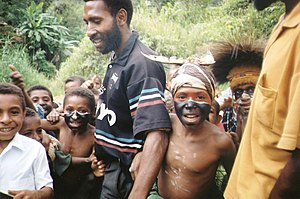Papuan people

Children dressed up for sing-sing in Yengisa, Papua New Guinea
|
|
| Regions with significant populations | |
|---|---|
| New Guinea (Papua New Guinea and West Papua (region), Indonesia), East Timor | |
| Languages | |
| Trans–New Guinea languages, Papuan languages | |
| Religion | |
| Christianity (Protestantism, Roman Catholicism), Animism, Islam | |
| Related ethnic groups | |
| Melanesians, Moluccans, Indigenous Australians |
Papuan is an umbrella term for the various indigenous peoples of New Guinea and neighbouring islands, speakers of the Papuan languages. They are often distinguished ethnically and linguistically from Austronesians, speakers of a language family introduced into New Guinea about three thousand years ago.
In a 2005 study of ASPM gene variants, Mekel-Bobrov et al. found that the Papuan people have among the highest rate of the newly evolved ASPM haplogroup D, at 59.4% occurrence of the approximately 6,000-year-old allele. While it is not yet known exactly what selective advantage is provided by this gene variant, the haplogroup D allele is thought to be positively selected in populations and to confer some substantial advantage that has caused its frequency to rapidly increase.
...
Wikipedia
